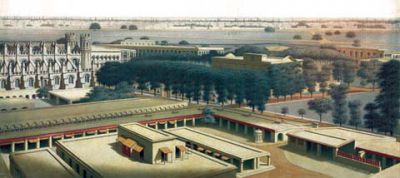Fort William
Fort William the most impressive edifice in Kolkata of the military power of the British Raj in the East. It still continues to serve as a citadel of the Indian army in Eastern India. There were actually two Fort Williams, the old and the new. The old fort goes back to the early days of the east india company. Sir Charles Eyre started the construction of the southeast bastion and the adjacent walls. His successor John Beard added the northeast bastion around 1701. He began the Factory or the Government House in 1702 in the middle of the fort and on completion in 1706; it was named after King William of England.

The actual site of the fort was the ground now occupied by the General Post Office, the Eastern Railway Office, The Custom House and the government offices in the vicinity. Although the raison d'EAtre of the fort was to ensure the safety and security of the company, it was structurally flawed from the very beginning. The court of directors of the East India Company commented in 1713 that although the fort made a very pompous show to the waterside by high turrets of lofty buildings, it lacked any real strength. Its efficacy was put to test in 1756 when Roger Drake, the governor of Fort William, provoked sirajuddaula to attack Calcutta. The Nawab captured Calcutta, entered the fort and, on 19 June 1756, forced Governor Drake and his people to evacuate the place. This was indeed the beginning of the end of the old Fort.
In the changed political context, the company needed a citadel, impressive enough to reflect its growing strength. Initially the company toyed with the idea of rebuilding the old fort and reinforcing its defence. Benjamin Robins and, after his death, Colonel Frederick Scott, in their official capacity as the Engineer Generals were involved in the process. But the Palashi Revolution changed everything. Gone were the days of mercantile mendicancy and robert clive recommended building a new fort at the present site. Accordingly, John Brohier, the engineer of Fort St. David (Bombay), was summoned to Calcutta to supervise the construction. In September 1758 the Bengal authorities of the company called upon Brohier to submit an estimate of expenditure. He calculated that the expense of finishing the citadel would vary between 21 and 22 lakhs of rupees. The amount was sanctioned and the construction of the new fort began under his supervision. But soon the engineer was arrested on charge of fraud and, though later released on parole, eventually vanished into thin air.
Despite this setback, the works continued and, by early 1761, it was reported that 'the place was almost completed except the gateways'. But though bulk of the work was completed by 1780 and the fort was ready for occupation during the time of warren hastings, actually many more works had to be subsequently undertaken in order to meet new challenges. The second phase of major construction started about a century later in the 1860s and continued till about the end of the century.
Fort William was designed in accordance with the accepted principles of modern fortification. In form it is an irregular octagon with five sides towards the land and three towards the river. A ditch that was usually filled with water by a sluice from the river surrounds it. The fort had seven gates as entry points. The early barracks in the fort were all one-storied. There was a garrison church within the fort, dedicated to St. Peter. Paucity of adequate water supply, lack of proper drainage system and prevalence of diseases of various types were some of the problems that the soldiery had to live with. It was only in the second half of the nineteenth century that new barracks were built, water scarcity taken care of and proper medical facilities extended to the inmates.
The company had already emerged as the supreme political power in Eastern India when the construction of the fort was completed. Therefore, the new Fort William was never called upon to perform the role of an active fort. Indeed Fort William stood no siege and no gun was ever' fired against an enemy from its ramparts. It was' an impressive showpiece fortress of the English in India. [Basudeb Chattopadhyay]
